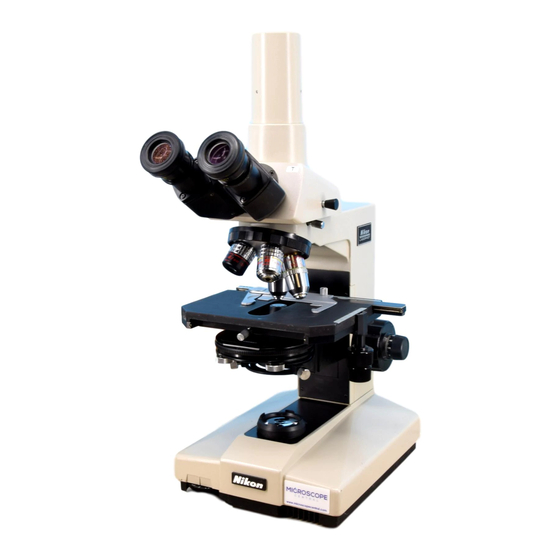Nikon Labophot Руководство по эксплуатации - Страница 13
Просмотреть онлайн или скачать pdf Руководство по эксплуатации для Микроскоп Nikon Labophot. Nikon Labophot 28 страниц. Y-r stand biological microscope

To see if air bubbles are present in the
immersion oil, which deteriorate the image
quality,
pullout
the eyepiece from the
eyepiece tube to examine the
objective
exit
pupil inside the tube.
To
remove
air bubbles,
revolve
the nose-
piece slightly
to and fro several times,
apply additional oil, or replace the oil.
Be careful not to rotate the nosepiece too
far as to soil the ends of the other objec-
tives with oil.
To clean off the oil, pass lens tissue or soft
cloth moistened with xylene lightly two or
three times
over
the lens. It is essential at
this time to avoid touching the lens with
the part of tissue or cloth once used.
Any remnants of oil left on the lens dete-
riorate the image quality.
(2) Coverglass
With the objectives engraved "160/0.17",
use a coverglass of O.17mm in thickness
(No. 1%). For the objectives whose N.A is
0.75 or higher, a coverglass of other thick-
ness than 0.17mm
will
deteriorate
the
image definition and contrast.
The indication
160/-
on the objective
means that no matter whether a coverglass
is used or not, no decrease of image defini-
tion or of contrast wi II resuIt.
(3) Objectives with compensation ring
When a high power, dry objective of large
N.A
is adopted
in combination
with
a
coverglass of thickness other than 0.17mm,
which will cause sharp reduction of image
definition
and contrast, it is necessary to
use an objective incorporating a compensa-
tion ring as below:
First, observe with the compensation ring
set to 0.17, and then rotating the ring,
focus the image with the fine focus knob,
until an image of the highest sharpness and
contrast is obtained.
(4) No-coverglass objectives (NCG)
Objectives with
the indication
NCG are
suited
for
observing specimens such as
smears without coverglass.
(5) Objectives with aperture diaphragm
The objective
incorporating
an iris dia-
phragm serves to cut off direct light in
darkfield
microscopy.
Stop
down
the
diaphragm nearly to its minimum opening.
13
2,
Eyepieces
To take full advantage of the CF eyepieces, use
them in combination
with the CF objectives.
The indication
"CF"
should
serve
to prevent
their use with other type objectives.
1) CFD eyepieces (CFD)
Being of wide field and high eyepoint type, the
CFD eyepieces are only used for observation,
obtains prominent
image flatness. Compared
with the CFW eyepieces, they accomplish the
good correction of chromatic aberrations at the
periphery of the viewfield in combination with
the
low
magnifying
power
of
CF
Plan
Apochromat objectives.
They are equipped with a diopter ring and a
rubber
eyeguard.
An eyepiece CFD
lOXM,
incorporating
a photo mask, is also
available,
which enables focusing and framing by the use
of
the
observation
tube of the Trinocular
Eyepiece Tube "T".
2) CFW eyepieces (CFW)
Being of wide field and high eyepoint type, the
CFW eyepieces with diopter ring are only used
for
observation.
They
are equipped
with
a
rubber eyeguard.
An eyepiece called CFW lOX M, incorporating
a photo mask is also available, which enables
focusing and framing by the use of the observa-
tion tube of the Trinocular Eyepiece Tube "T".
3) CFUW eyepiece (CFUW)
Featuring
extra-wide
field of view and high
eyepoint,
this eyepiece with
diopter
ring is
designed exclusively for observation. It enables
observation over a field of view twice as large as
that of the ordinary type eyepieces in combina-
tion with the ultra-wide tube.
An eyepiece called CF UW lOXM, incorporating
a photo mask, is also available, which enables
focusing and framing by the use of the observa-
tion
tube of the Ultra Wide Eyepiece Tube
"UW".
4) CF PL Projection lenses(CF PL)
Exclusively designed for photomicrography.
Do
not use them for observation.
Every eyepiece is liable to gather dirt and dust,
which
not only appear as shadows but also
impair image quality and contrast.
Keep the eyepieces clean at all times.
